
Safari airboat ride reveals Glades’ beauty
After my first trip down Calle Ocho and 17 long miles of construction and traffic on a one-way road in the middle of nowhere, I finally arrived at Everglades Safari Park.
I was very tempted to just pull over at the first giant sign I saw for “airboat rides” but, after passing about four different parks, I approached the sign for the Safari Park.
| At right, Everglades Safari Park airboat guide and pilot Lisa Cohn sits high above the water (Photos by Rachel Janosec). Below, an alligator rests on a rock. | 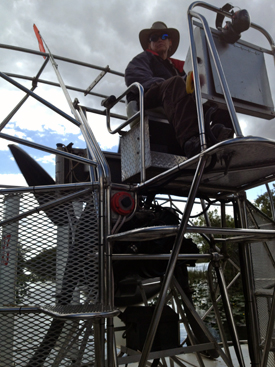 |
The ride there wasn’t too bad, but the parking lot was packed once I got there. I almost couldn’t find a place to park and I had no clue where to go or what I was doing. I ended up traveling alone to the park since my partner was sick, so much of this trip was really planned on a limb.
I paid a very modest $23 for my airboat ride, which to my surprise included an alligator show.
“Lisa, hold the boat we have one more, Lisa!” said the park ranger over his walkie-talkie as the airboat in dock one was slowly floating away.
Next, the park ranger told me to quickly run to dock one because they had one more spot for me and were leaving now!
Lisa Cohn, the airboat guide and pilot of the boat, had to reverse back into the dock and wait for me. The passengers on the boat, including Lisa, didn’t seem thrilled.
Most seemed quite angry that they were held up. But the park rangers and Lisa were very helpful and got me on the first available boat.
The next thing I knew I was out in the middle of the water in the region of the Everglades and I thought to myself, “how did I get here?”
As the airboat was pulling away from the dock, Lisa pointed out two huge alligators sunbathing and hanging out right at the entrance of the park. I think they somehow placed them there for show.
Lisa, the airboat guide, handed out bright orange earplugs to everyone and gave me mine when we were halfway out into the water because I arrived late. I have never been on an airboat tour before, although my father swears he brought me to the Everglades as a child and I just don’t remember.
But, at this point, I had no idea what the earplugs were for.
I turned to this tall man sitting next to me on the boat and said what are these for, his reply back was simply him just pointing to the bag and giving me thumbs up. And that’s when I knew I was in for a journey.
I soon realized that the airboat I was on was filled with foreign visitors who didn’t speak English. I was essentially alone in the middle of the Everglades. Everyone else had family with them and could understand each other, but not me. I assumed my fellow passengers were mostly from Europe and spotted one lady at the front of the boat wearing a light pink sweatshirt that said SWEDEN, in big bold writing.
For the entire ride, which was about 30 to 40 minutes, I couldn’t communicate with anyone. Then, of course, it started raining and I was not dressed properly. For about the first half of the ride, no one spoke, I was wet, bored and saw only one animal, which was a bird flying above me. Also, the noise of the airboat was almost deafening and that is when I figured out the purpose of the earplugs. I almost thought I got ripped off and this trip was a waste of my time.
| At left, writer Rachel Janosec holds Snappy, the baby crocodile, at the alligator and crocodile show. Next, a view of the Everglades Safari Park while riding the airboat back to the park headquarters. |
After our long, wet and boring trip, we finally made it to the middle of the water in the Everglades region. This is when the ride became exciting and interesting. Lisa stopped the boat and gave us a quick history lesson of the area.
The region of the Everglades has been reduced from eight million square feet to one million square feet since 1930 due to progress in South Florida’s economy and development.
Native American Indians, known as the Creek Indians, lived here and called this home for most of their lives, but many had left by 1930. There are about 40 different mammals that live out here on large land masses called hammocks, but I got to see just two. Today, there is about 36 different species of wildlife in the Everglades.
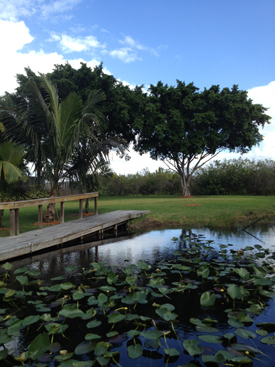 Lisa also informed us that there is major restoration currently happening in the park starting with the road construction along SW 8th Street on the way to the park. This explained all the traffic and my long commute.
Lisa also informed us that there is major restoration currently happening in the park starting with the road construction along SW 8th Street on the way to the park. This explained all the traffic and my long commute.
She said that the pure water goes into the Florida aquifers in which Florida residents rely on for drinking water. The water was so murky and filled with plants and mud; I kept thinking to myself I would never want to drink this water.
I also kept thinking about getting stuck out in the middle of the Everglades and how one would survive. Then Lisa brought this topic up.
“The tall grass you see out here surrounding us is called sawgrass. The sawgrass and the pure water can be used for survival if you were stuck out here. Indians did it for a while and you guys could, too. The Indians basically could find and eat whatever they wanted out here. If they wanted fish they would catch that, if they wanted meat for dinner that night they would go out and catch that,” Lisa stated.
One animal we saw, besides the alligators, was a snake, also known as my least favorite animal.
There are 27 species of snakes that call the Everglades home. And thank God we only saw one of them. Four out of the 27 are venomous. One of these venomous snakes is called the Water Moccasin, which is a blackish brown little slimy creature.
The water moccasin can live on water or land and we saw him on land, from far away thankfully. The most venomous snake in the world also lives out here. This snake is called the Coral Snake and is only two feet long and is related to the Cobra family. There is also three species of rattlesnakes in the Everglades, which all shake their tails when they smell intrusion.
Once the rain cleared and the sky was blue again, I realized what a beautiful area I was visiting. The ride back in was what I enjoyed the most. The sky cleared and the wind and sun was hitting my face as Lisa drove the boat back slowly so we could see the alligators sunbathing on the rocks. The ride was actually very peaceful and surreal, and very educational. You are just surrounded by nothing but tall grass, plants, water, sun, breeze and wildlife; all your worries seem to disappear for the time being.
On the way back in to the dock, I saw a beautiful purple and blue bird, only the second bird I saw the whole ride. The Purple Gallinule bird was just sitting on the dock by itself and was very cute and small.
One the way in, Lisa stopped whenever we passed by an alligator. We got up so close to these creatures that is was shocking and they didn’t even flinch. Most were sleeping and even had their eyes closed. Some were by themselves just lying on the rocks in the hot South Florida sun and some were lying on top of each other or in packs.
| At right, a purple gallinule bird spotted on the way back in. Next, sunny the snake at the alligator show. And last, the largest Nile crocodile in the park. | 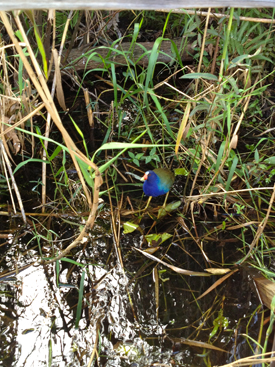 |
Airboats were going out and coming in as we re-entered into our dock area and the park seemed doubly crowded. As we got off the boat, All I know is that this was the most exciting part of the trip. Just as I thought all I was going to see was a bird or two, we came upon all these alligators and everyone on the boat was standing up taking pictures. It was quite the sight to see and quite the experience.
Eddie Reyes, the park ranger and alligator show host, waved us over to the stage for the show.
Eddie fed the alligators and explained how you can tell an alligator apart for a crocodile. A small boy in the audience raised his hand and told us you can tell them apart by the shape of the snout. One is more round than the other and that is the major indicator when trying to tell them apart. Going into this, I had no idea myself and thought they were all just the same.
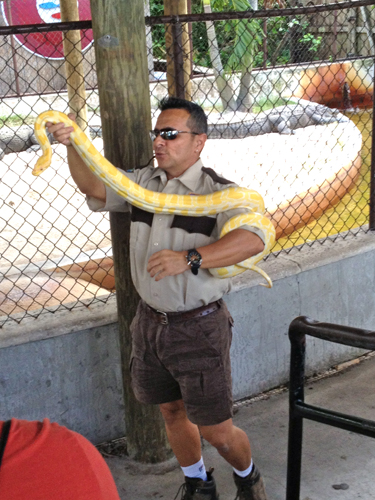 Everglades Safari Park has some crocodiles in captivity in the park for visitors to see and for the shows. But on the airboat tour, I only saw alligators because crocodiles don’t live in the wild area around the park.
Everglades Safari Park has some crocodiles in captivity in the park for visitors to see and for the shows. But on the airboat tour, I only saw alligators because crocodiles don’t live in the wild area around the park.
Eddie brought out a baby alligator named Snappy that was only a few weeks old and let us hold him and take pictures with him, which all the little kids loved. He also brought out a large yellow and white snake named Sunny that we were able to touch, and I got over my fears and gave him a little pet on the back.
Once the show was over we were able to walk around the park and through museums of animals and we could see the gators close up in cages. I told Eddie I was a student and was writing a story for class so he very nicely gave me my own private tour of the park.
“The largest crocodile we have here is from Cuba and is called the cayman crocodile. Some are from Australia and many other places all around the world. The cayman one is vicious and will chase you down and kill you. The crocodiles are more vicious then the alligators,” Eddie explained.
Eddie also answered my question about the large population of people here from Europe who didn’t speak English. He explained that most of them are from Europe and have stopped in Miami during a cruise.
“The cruise ship stops here for the day and lets them explore the Everglades,” he said.
My trip ended with a delicious order of alligator bites from the restaurant at the park. The bites are made up of alligator tail that is marinated for 72 hours, breaded and fried to perfection for only $7. And, yes, it did take a lot of convincing for me to try these things, but they were awesome and a perfect way to conclude my trip to Everglades Safari Park.
If You Go
Everglades Safari Park is located at 26700 SW 8th St., Miami, Fla. 33194.
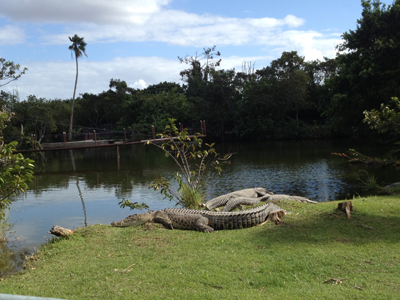 Directions: Drive west from Miami along SW 8th Street (also known as U.S. 41 and Tamiami Trail) until you see the sign.
Directions: Drive west from Miami along SW 8th Street (also known as U.S. 41 and Tamiami Trail) until you see the sign.
Telephone 305-226-6923, ext. 7.
Activities: Airboat rides, alligator shows, museums and food.
Getting There: Leave early for the park and be aware of the major road construction that is going on.
Restaurant: Picnic Time Restaurant is popular with visitors and usually has a wait. Keep in mind that there are not many other restaurants close by.
Admission: $23 for the tour and show and a reduced price of $12 for kids under 13 years old.
Attire: Dress appropriately for occasional rain and wind.
Photos: Bring your camera.
E-mail address: picnictimesafari@hotmail.com.

Comments are Closed